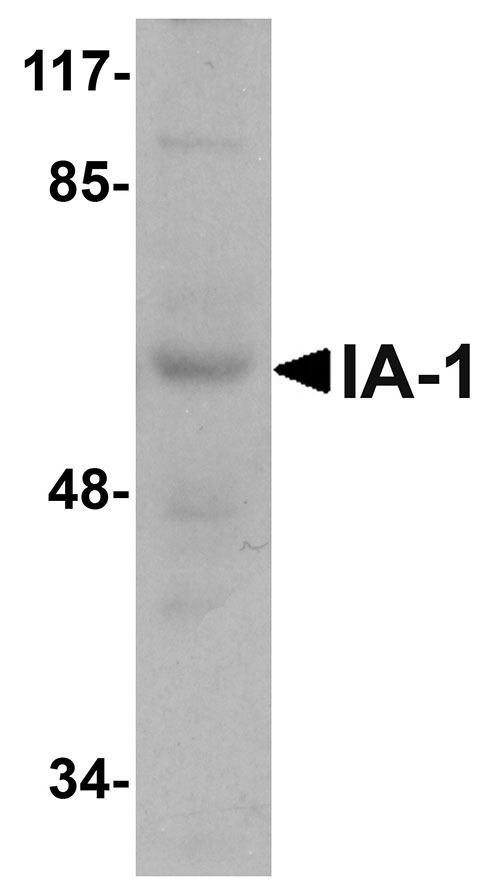IA-1 Antibody
- 产品详情
- 实验流程
- 背景知识
Application
| WB, E |
|---|---|
| Primary Accession | Q01101 |
| Other Accession | NP_002187, 4504713 |
| Reactivity | Human, Mouse, Rat |
| Host | Rabbit |
| Clonality | Polyclonal |
| Isotype | IgG |
| Calculated MW | 52923 Da |
| Concentration (mg/ml) | 1 mg/mL |
| Conjugate | Unconjugated |
| Application Notes | IA-1 antibody can be used for detection of IA-1 by Western blot at 1 µg/mL. |
| Gene ID | 3642 |
|---|---|
| Other Names | Insulinoma-associated protein 1, Zinc finger protein IA-1, INSM1, IA1 |
| Target/Specificity | INSM1; |
| Reconstitution & Storage | IA-1 antibody can be stored at 4℃ for three months and -20℃, stable for up to one year. As with all antibodies care should be taken to avoid repeated freeze thaw cycles. Antibodies should not be exposed to prolonged high temperatures. |
| Precautions | IA-1 Antibody is for research use only and not for use in diagnostic or therapeutic procedures. |
| Name | INSM1 |
|---|---|
| Synonyms | IA1 |
| Function | Sequence-specific DNA-binding transcriptional regulator that plays a key role in neurogenesis and neuroendocrine cell differentiation during embryonic and/or fetal development. Binds to the consensus sequence 5'-[TG][TC][TC][TT][GA]GGG[CG]A-3' in target promoters. Acts as a transcriptional repressor of NEUROD1 and INS expression via its interaction with cyclin CCND1 in a cell cycle- independent manner. Negatively regulates skeletal muscle-specific gene expression in endocrine cells of the pituitary by inhibiting the Notch signaling pathway. Represses target gene transcription by recruiting chromatin-modifying factors, such as HDAC1, HDAC2, HDAC3, KDM1A and RCOR1 histone deacetylases. Binds to its own promoter, suggesting autoregulation as a self-control feedback mechanism. Competes with histone H3 for the same binding site on the histone demethylase complex formed by KDM1A and RCOR1, and thereby inhibits demethylation of histone H3 at 'Lys-4' (PubMed:23721412). Promotes the generation and expansion of neuronal basal progenitor cells in the developing neocortex. Involved in the differentiation of endocrine cells of the developing anterior pituitary gland, of the pancreas and intestine, and of sympatho-adrenal cells in the peripheral nervous system. Promotes cell cycle signaling arrest and inhibition of cellular proliferation. |
| Cellular Location | Nucleus {ECO:0000250|UniProtKB:Q63ZV0}. |
| Tissue Location | Expressed in pancreatic duct cells. Expressed in several tumor cell lines of neuroendocrine origin including pheochromocytoma, medullary thyroid carcinoma, insulinoma, medulloblastoma, retinoblastoma, pheochromacytoma, medullary thyroid carcinoma and small cell lung carcinoma. |
For Research Use Only. Not For Use In Diagnostic Procedures.
Provided below are standard protocols that you may find useful for product applications.
BACKGROUND
IA-1 Antibody: IA-1, also known as INSM1, is an essential five zinc-finger transcription factor that while initially identified from an insulinoma cDNA library, is expressed in the developing nervous system. Specifically, IA-1 is expressed as early as E9.5 in mice in the fore-, mid- and hindbrain, spinal cord, retina, and olfactory bulb. It is thought that IA-1 functions as a transcriptional repressor, and is a part of several signaling pathways including those of Notch and sonic hedgehog in addition to that of Ngn3 during pancreatic endocrine cell differentiation. IA-1 is also expressed in multiple tumors, including the majority of neuroendocrine tumors tested so far as well as nearly 100% of all small cell lung carcinomas, indicating that IA-1 may be an important target in cancer therapy.
REFERENCES
Lan MS, Li Q, Lu J, et al. Genomic organization, 5’-upstream sequence, and chromosomal localization of an insulinoma-associated intronless gene, IA-1. J. Biol. Chem.1994; 269:14170-4.
Jacob J, Storm R, Castro DS, et al. Insm (IA-1) is an essential component of the regulatory network that specifies monoaminergic neuronal phenotypes in the vertebrate hindbrain. Dev.2009; 136:2477-85.
Breslin MB, Zhu M, and Lan MS. NeuroD1/E47 regulates the E-box element of a novel zinc-finger transcription factor, IA-1, in developing nervous system. J. Biol. Chem.2003; 278:38991-7.
Nelson BR, Hartman BH, Georgi SA, et al. Transient inactivation of Notch signaling synchronizes differentiation of neural progenitor cells. Dev. Biol.2007; 304:479-98.
终于等到您。ABCEPTA(百远生物)抗体产品。
点击下方“我要评价 ”按钮提交您的反馈信息,您的反馈和评价是我们最宝贵的财富之一,
我们将在1-3个工作日内处理您的反馈信息。
如有疑问,联系:0512-88856768 tech-china@abcepta.com.























 癌症的基本特征包括细胞增殖、血管生成、迁移、凋亡逃避机制和细胞永生等。找到癌症发生过程中这些通路的关键标记物和对应的抗体用于检测至关重要。
癌症的基本特征包括细胞增殖、血管生成、迁移、凋亡逃避机制和细胞永生等。找到癌症发生过程中这些通路的关键标记物和对应的抗体用于检测至关重要。 为您推荐一个泛素化位点预测神器——泛素化分析工具,可以为您的蛋白的泛素化位点作出预测和评分。
为您推荐一个泛素化位点预测神器——泛素化分析工具,可以为您的蛋白的泛素化位点作出预测和评分。 细胞自噬受体图形绘图工具为你的蛋白的细胞受体结合位点作出预测和评分,识别结合到自噬通路中的蛋白是非常重要的,便于让我们理解自噬在正常生理、病理过程中的作用,如发育、细胞分化、神经退化性疾病、压力条件下、感染和癌症。
细胞自噬受体图形绘图工具为你的蛋白的细胞受体结合位点作出预测和评分,识别结合到自噬通路中的蛋白是非常重要的,便于让我们理解自噬在正常生理、病理过程中的作用,如发育、细胞分化、神经退化性疾病、压力条件下、感染和癌症。






